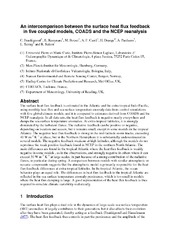| dc.description.abstract | The surface heat flux feedback is estimated in the Atlantic and the extra-tropical Indo-Pacific, using monthly heat flux and sea surface temperature anomaly data from control simulations with five global climate models, and it is compared to estimates derived from COADS and the NCEP reanalysis. In all data sets, the heat flux feedback is negative nearly everywhere and damps the sea surface temperature anomalies. At extratropical latitudes, it is strongly dominated by the turbulent fluxes. The radiative feedback can be positive or negative, depending on location and season, but it remains small, except in some models in the tropical Atlantic. The negative heat flux feedback is strong in the mid-latitude storm tracks, exceeding 40 W m-2 K-1 at place, but in the Northern Hemisphere it is substantially underestimated in several models. The negative feedback weakens at high latitudes, although the models do not reproduce the weak positive feedback found in NCEP in the northern North Atlantic. The main differences are found in the tropical Atlantic where the heat flux feedback is weakly negative in some models , as in the observations, and strongly negative in others where it can exceed 30 W m-2 K-1 at large scales, in part because of a strong contribution of the radiative fluxes, in particular during spring. A comparison between models with similar atmospheric or oceanic components suggests that the atmospheric model is primarily responsible for the heat flux feedback differences at extra-tropical latitudes. In the tropical Atlantic, the ocean behavior plays an equal role. The differences in heat flux feedback in the tropical Atlantic are reflected in the sea surface temperature anomaly persistence, which is too small in models where the heat flux damping is large. A good representation of the heat flux feedback is thus required to simulate climate variability realistically. | en_US |
